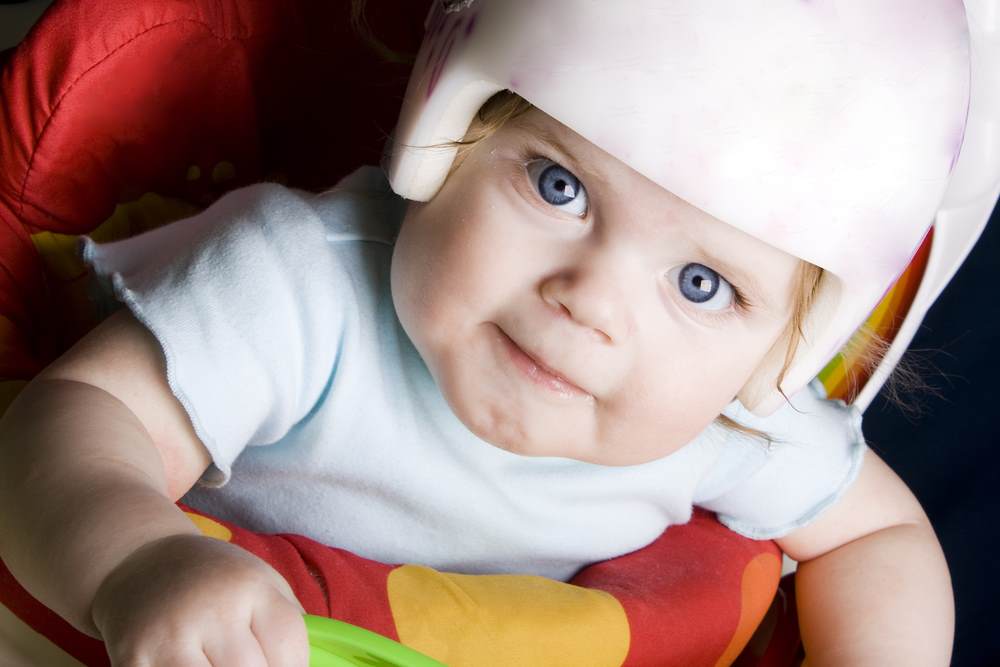Your Baby’s Head Shape
Parents of a newborn are faced with a seemingly endless list of things to worry about as their child develops. One of the most common concerns is regarding their baby’s head shape. Many newborns have slightly uneven heads. This is usually the result of the child’s head being molded unevenly while passing through the birth canal during delivery. In other instances, a baby’s head shape may have been affected after birth by pressure on the back of the head when lying on their back.
Flat spots on your baby’s skull

During the first four to six months of life, your baby’s skull is thin and malleable. As a result of resting the head in the same position often, an uneven head shape can develop and linger past the time when birth-related lopsidedness evens out. This is called positional molding. You’re most likely to notice positional molding when looking down on your baby’s head from above. One side of your infant’s head might appear flatter on one side than the other. Flat spots related to pressure on the back of the head do not cause brain damage or interfere with your baby’s development, but the cosmetic aspect of the issue can cause parents a great deal of unnecessary worry. As your baby grows, he or she will develop better head and neck control, resulting in pressure being more evenly distributed on the skull, and his or her head will naturally round out.
Adjusting how you position your baby can minimize unevenness and speed up the rounding out process:
- Continue to place your baby on his or her back to sleep, but alternate the direction your baby’s head faces in the crib.
- Alternate placement of your infant’s body in the crib: place your baby’s head near the foot of the crib one day, the head of the crib the next.
- Alternate which arms your baby rests on each feeding.
- If your baby returns to the position causing the flattening while sleeping, do not wake them. Simply adjust his or her position the next time they sleep.
- Hold your baby frequently, as this will help relieve pressure on your baby’s head from the crib, swings, carriers, or infant seats.
- Under close supervision, place your baby on his or her tummy on a firm surface frequently.
Positional plagiocephaly
Occasionally, an infant may continue resting his or her head on one particular side even after developing more head and neck control, resulting in a more severe form of skull flattening. This condition is known as positional plagiocephaly. Positional plagiocephaly does not affect brain growth or development, but correcting the problem is time-sensitive.
Treatment of positional plagiocephaly
It’s important to begin treating this problem early, as regular repositioning of the baby from the flattened side of the skull will prevent the flattening from becoming more severe. Surgery is very rarely needed. Dr. Leung can perform a physical exam to make a diagnosis of positional plagiocephaly. Consistent repositioning can accelerate the rounding out process and give the child’s head a more even shape by the age of four or five years old.
Tips to encourage repositioning:
- When your baby is lying on his or her back, gently turn the head to the side that is not flat to prevent pressure to the flat spot. Do NOT use anything to keep the head in place, simply encourage the baby to rest their head on the non-preferred side.
- Try using Velcro to fasten a toy or rattle to the hand on your baby’s non-preferred side or hold toys on the non-preferred side to encourage them to look in that direction, relieving pressure to the flat side.
- Limit the time your baby spends in swings or baby carriers. When the baby is able to sit up, pressure will be taken off the back of the head. This also builds their neck strength.
- Increase the amount of supervised tummy time when the child is awake.
- When you hold your baby, use a position that avoids pressure to the flattened side of the head.
If regular repositioning is not successful in helping the head to round out, Dr. Leung may recommend the use of a custom helmet to redirect head growth.
Helmets and head shape
If your baby’s skull has not rounded out by the age of 6 months, a custom-fitted helmet to prevent pressure on the flattened side of your baby’s head is typically effective. Molded helmets are most successful in reshaping a baby’s head when treatment begins while the skull is still malleable and the brain is growing rapidly. This is usually between four and six months. Treatment after the skull bones are fused together and head growth slows is likely to be ineffective, so timely intervention is key.
Torticolis
Occasionally an underlying muscular issue called torticollis causes an infant to hold his or her head tilted to one side. In this scenario, physical therapy is needed. Physical therapy will help stretch the affected muscles, allowing the infant to move their head freely and change position more easily.
Craniosynostosis
Craniosynostosis occurs when one or more of the junctions between the bones of the skull close early. Premature fusion of these bony plates can force the skull to grow in an unusual shape. In rare instances, early suture closure can also restrict overall skull growth which may be harmful to the brain. In most infants, the cause of craniosynostosis is unknown and the child is otherwise healthy. In certain children, the cause is genetic. If Dr. Leung suspects an underlying genetic syndrome, genetic testing may help identify it. The condition occurs in one out of every 2,000 to 2,500 live births.
Symptoms of craniosynostosis
The most obvious indication of craniosynostosis is an abnormally shaped head. The soft spot may be open or closed. Occasionally, head growth measurements will be seen to fall off of expected growth charts used at your baby’s well visits. This will lead to build-up of pressure inside the skull. Symptoms of high pressure may include:
- Lethargy (very sleepy, difficult to wake)
- Difficulty moving eyes up
- Keeping eyes down all of the time
- Bulging and/or tense soft spot
- Headache
- Nausea and vomiting
Dr. Leung may diagnose craniosynostosis during an office exam. However, occasionally a computerized tomography (CT) scan, a cranial ultrasound, or magnetic resonance imaging (MRI) may be required to more closely examine the cranial sutures and confirm the diagnosis.
Craniosynostosis treatment
In order to provide the baby’s brain with enough space to grow and develop, the fused bones must be surgically separated during infancy. Left untreated, craniosynostosis can result in more extreme cranial deformity and present a threat to overall head growth and potentially increase intracranial pressure. In addition, the condition can present psychosocial challenges for the child in their interactions with other children.
Conclusion
It is completely normal for a baby’s head to appear misshapen after birth and in the first few months of life. Most heads will round out as the infant develops. However, some babies may need a little extra help. If you are concerned about your baby’s head shape, please give our office a call for an appointment at 469-425-3600.

